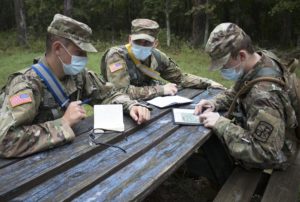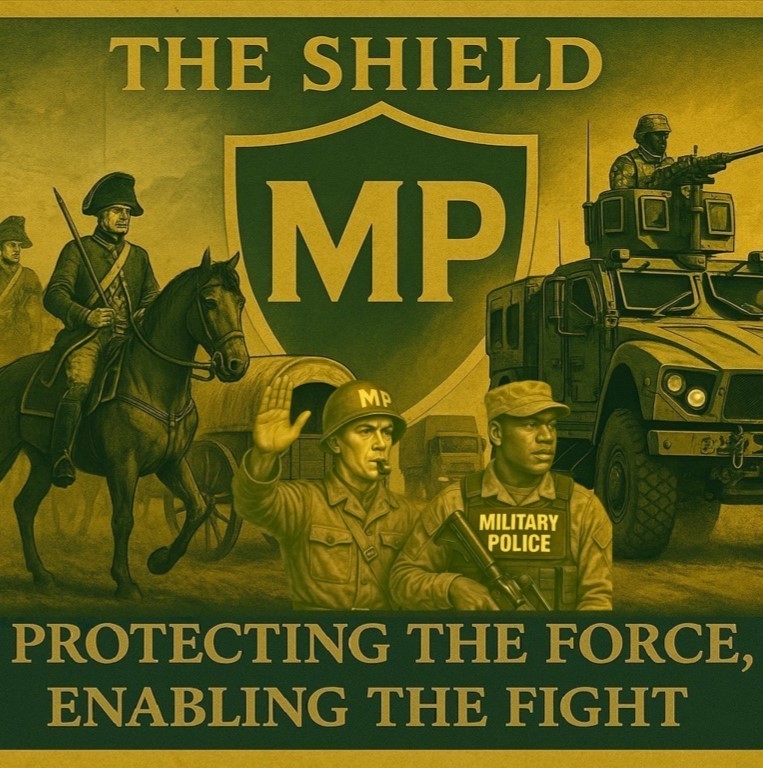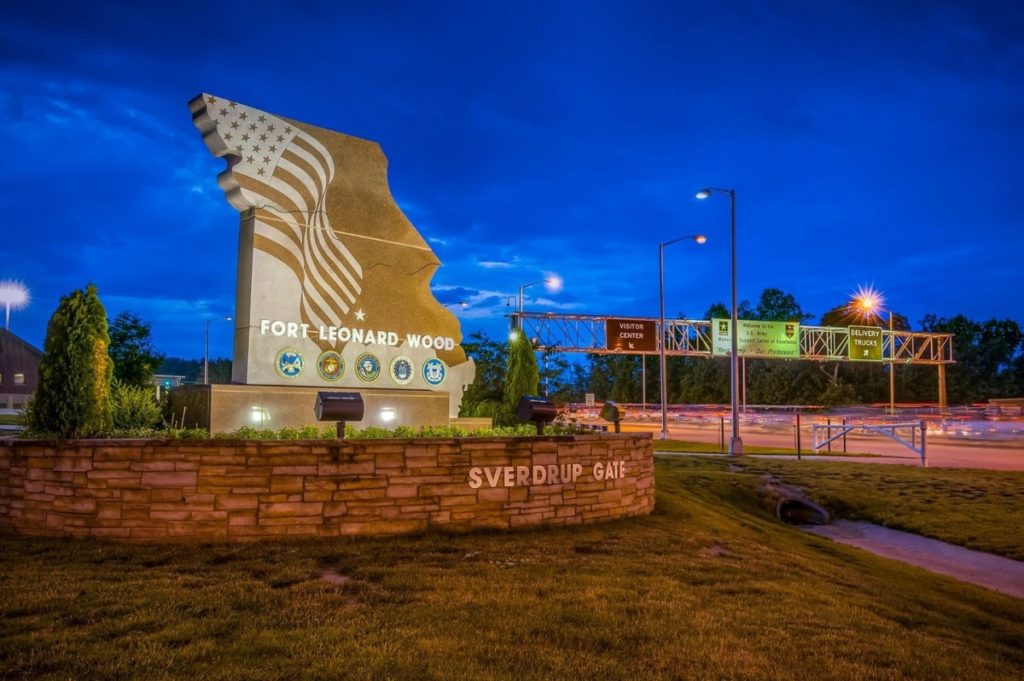Sam Campbell
FORT LEONARD WOOD, Mo. (Sept. 18, 2020) — Cadets from the Army ROTC detachments at the University of Missouri in Columbia and Missouri University of Science and Technology in Rolla participated in field training and team development this weekend at Fort Leonard Wood.
From Sept. 11 through 13, 77 Mizzou freshmen and sophomores — or MSI and MSII — teamed up to engage in virtual call-for-fire exercises, 360-degree Humvee simulators, land navigation, ruck marches and setting up a patrol base.
Thirty cadets from S&T’s Stonehenge Battalion practiced team development exercises and surmounted a series of obstacles at the Physical Endurance Course Saturday — they’re scheduled to return to Fort Leonard Wood for their field training later this month.
The universities screened all cadets for COVID-19 symptoms in the two weeks leading up to their visit, according to Mizzou and S&T cadre.
Cadet Katie Spencer is an S&T freshman from Waynesville whose parents served in the Army.
“It’s been a blast,” she said. “I just feel like I’m going to make a lot of friends. I definitely hope I get to be put into the position to help people and become a really good leader.”
Their detachment commander, Lt. Col. Lonnie Pirtle, said he is thankful for the opportunity Rolla’s location affords his cadets.
“We’re very fortunate with our proximity to Fort Leonard Wood and it being one of the Army’s most premier, leading training installations,” he said. “We are extremely appreciative of the support we receive there.”
Mizzou’s MSI and MSII cadets reacted to incoming fire in a fictional convoy mission at the Reconfigurable Vehicle Tactical Trainer — a multimillion-dollar virtual training facility. Inside, four mock Humvees were stationed in separate octagonal rooms completely illuminated by eight projectors each, beaming visions of an area of operations on the surrounding walls.
Simulator M4 rifles and M240 machine guns produced realistic recoil and imitation sounds. Improvised explosive devices, ambient noise and gunshots echoed throughout the chambers, which made communication inside — and among — vehicles a vital key to success, cadets said.
“I thought … it’d be like a game, but really when you get in, it really is more like a simulation,” MSI Cadet Caimin Hayes said. “You have to work with your team, and if you don’t, things are going to go south. The first couple times we went, it was a bit of a mess. And then, as we got more experience, you could see how much better we did as a team.”
“We realized if this was real — we need to pick it up, do a lot better than that,” MSI Cadet Jennifer Boettinger added. “It just goes to show when it’s not a simulation how tough it can really be.”
Facility instructors said the environment can be so realistic and challenging that even active-duty groups need more than one try to make it through “alive.” Don Henley, RVTT principle training facilitator, said he enjoyed hosting the cadets as they reminded him of his own son who serves in the Army.
“It’s really exciting for me because they’re up and coming officers; they’re the new generation of the military,” he said. “I always strive to train everyone who comes to the facility like they’re my son.”
Following mounted patrol tactics, cadets practiced call-for-fire exercises, learning proper radio procedures, location and designation of distant enemy targets in a virtual environment.
“Once we called in a certain point, we would see where the artillery would land, and then from that, we would try and use our binoculars to zero in — or what they use is called ‘bracketing’ — to pinpoint our fire on the enemy or whatever we’re trying to hit,” Hayes said. “MSIs, that was our first time doing that.”
Capt. Jonathan Hughes, an assistant professor of military science with Mizzou, supervised the training and praised the installation’s capabilities.
“Fort Leonard Wood has probably the best facilities for training, and (it’s) the most user-friendly installation I’ve ever trained at,” he said. “Today, I was able to set up a Call For Fire Trainer, go down to the RVTT, have those guys work that system, open a range, sign for weapons here, sign for ammo which was brought out to the range for us — we wouldn’t be able to do any of this that we’re doing today if it wasn’t for the way that Fort Leonard Wood’s set up.”
Juniors — or MSIIIs — operated individually throughout the weekend and were assessed on their leadership potential, according to Master Sgt. Gambit Olvera, who was on the ground with his students.
For MSIII Cadet Madison Raney, who hopes to join the Judge Advocate General’s Corps, this was her first trip to Fort Leonard Wood.
“It’s super cool that we’ve been able to come out here, use the equipment and the ranges,” she said. “There’s a certain level of humility you get with positions that you’re offered in this program. You get an opportunity to help people who maybe aren’t so confident themselves, help them grow in that confidence. As a leader, it’s really challenged me to get out of my comfort zone.”
Olvera, who serves as the commandant of cadets at Mizzou’s ROTC detachment, said that in addition to exposing the older class to authoritative opportunities, his program aimed to familiarize the juniors with firing standard-issue rifles.
“We want them to be able to zero and qualify their weapon,” he said. “We want them to be proficient at land navigation, and of course, we want them to have confidence.”
While freshmen and sophomores in the program have more time, junior cadets will be evaluated on marksmanship this summer at Cadet Summer Training Advanced Camp — an excursion 40 percent of which is meant to evaluate leadership ability, cadre said.
“It’s more about leadership in the ROTC program, basic training is more learning how to be a Soldier and following orders,” Raney said. “It’s definitely interesting being on the other side of that. Now, I’m kind of learning how to put myself in that leadership role, teaching other people how to be Soldiers.”
For the younger cadets, the weekend here was merely an introduction to the U.S. Army.
“They’ve done a couple of two-hour labs at the university, but this is, yes, absolutely, the first real Army training that freshmen get,” Olvera said. “Because of COVID-19, this will really only be the second time our sophomores have gone out.”
Even so, the trip proved to be an enjoyable way for cadets to determine a path ahead in their educational and professional careers.
“A lot of these kids have never done a rappel tower, and they’ll find out they love this stuff (like) sleeping in the woods,” Olvera said. “So, this is really to see if they really want to be in something like the Army.”




-30-
About Fort Leonard Wood
Fort Leonard Wood is a thriving and prosperous installation that has evolved from a small basic training post more than 75 years ago to a premier Army Center of Excellence that trains more than 80,000 military and civilians each year.
Fort Leonard Wood is home to the U.S Army Maneuver Support Center of Excellence and three U.S. Army schools: the U.S. Army Engineer School; U.S. Army Chemical, Biological, Radiological and Nuclear School; and the U.S. Army Military Police School. In addition to training engineer, CBRN and military police specialties for the Army, Fort Leonard Wood also provides gender-integrated in-processing and Basic Combat Training for new Soldiers.
Fort Leonard Wood also hosts and trains with the largest Marine Corps Detachment and Air Force Squadron on any Army installation as well as a large Navy construction detachment.
More information about Fort Leonard Wood is at: https://home.army.mil/wood/index.php/about/mission


